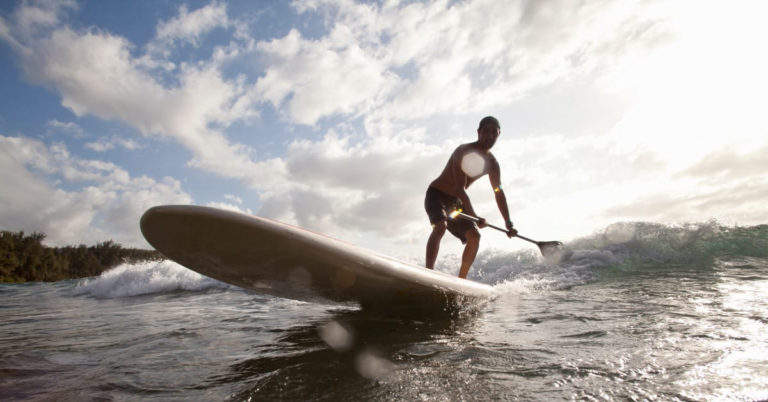Stand-up paddle boarding (SUP) is an exhilarating water sport that allows enthusiasts to glide across lakes, rivers, and coastal waters while standing on a board. In the UK, where weather conditions can be quite variable, understanding how these elements affect your SUP experience is crucial for maximizing enjoyment and safety. This article explores how different weather conditions impact SUP boarding, helping paddlers make the most of their time on the water.
The Impact of Wind on SUP Boarding
Wind is a significant factor affecting stand-up paddle boarding. In the UK, gusty winds can create challenging conditions for paddlers. On a calm day, a gentle breeze might provide a refreshing experience, but strong winds can make paddling difficult and potentially dangerous.
When the wind is strong, it can create choppy water conditions, making it hard to maintain balance on your paddleboards. This instability can be particularly challenging for beginners who may struggle to stay upright. Additionally, strong winds can push you off course, requiring more effort to steer and navigate.
For experienced paddlers, strong winds can offer an opportunity to test skills and enjoy a more dynamic ride. However, it’s important to exercise caution and consider wind direction and intensity before heading out. Wind forecasts and local conditions should be checked regularly to ensure safe paddling conditions.
Rain and Its Effects on Stand-Up Paddle Boarding
Rain is another weather condition that can influence your SUP experience. While rain itself may not pose a significant hazard, it often comes with other changes in weather patterns that can affect your stand up paddle board session.
Heavy rain can lead to increased water flow in rivers and streams, creating stronger currents. This can make paddling more strenuous and potentially dangerous, especially for those who are not experienced in handling such conditions. Additionally, rain can lead to reduced visibility, making it harder to see obstacles or other watercraft.
On the other hand, light rain or drizzle might not significantly impact your paddling experience. However, it is always advisable to be prepared for changing weather conditions and to dress appropriately to stay comfortable. Waterproof clothing and accessories can help protect against the elements and enhance your overall enjoyment.
Temperature Extremes and Their Impact
The UK’s weather can be quite variable, with temperatures ranging from chilly winters to mild summers. Extreme temperatures can influence your stand-up paddle-boarding experience, affecting both comfort and safety.
In colder weather, the risk of hypothermia is a concern, especially if you fall into the water. It’s essential to wear appropriate thermal clothing and a wetsuit to stay warm. Additionally, cold temperatures can affect the performance of your paddleboard, with some materials becoming less flexible and responsive.
Conversely, hot weather can lead to overheating and dehydration. Staying hydrated and wearing sun protection is crucial when paddling in sunny conditions. It’s also important to ensure that your paddleboard and other equipment are well-maintained, as prolonged exposure to sunlight can cause wear and tear.
Tides and Currents: Understanding Their Influence
In coastal areas of the UK, tides and currents play a significant role in stand-up paddle boarding. Tides can vary throughout the day, affecting water levels and flow patterns. Understanding tidal schedules is essential for planning your paddling sessions, as high or low tides can significantly impact water conditions.
During low tide, exposed sandbanks or rocks can create obstacles that may not be visible at high tide. Paddling during high tide often provides smoother conditions, but it’s important to be aware of potential strong currents that can develop.
Currents can also affect your paddling effort and direction. When paddling against a current, you may need to exert more energy to make progress, while paddling with the current can help you cover distance more quickly. Being aware of local currents and planning your route accordingly can enhance your SUP experience.
Visibility and Light Conditions
Visibility is an important factor in SUP boarding, especially in the UK, where weather conditions can change rapidly. Fog, mist, and low light can reduce visibility and make it harder to navigate and spot potential hazards. It’s essential to use proper lighting and reflective gear if you’re paddling in low-light conditions or at dawn and dusk.
Good visibility not only helps you see obstacles but also ensures that other water users can see you. Wearing bright or fluorescent clothing and using lights on your paddleboard can improve safety and visibility.
Conclusion
In summary, UK weather conditions can have a significant impact on your stand-up paddle-boarding experience. Wind, rain, temperature extremes, tides, currents, and visibility all play a role in shaping your time on the water. By understanding and preparing for these conditions, you can ensure a safer and more enjoyable SUP experience. Whether you’re a seasoned paddler or a beginner, being aware of the weather and its effects on your paddleboard will help you make the most of your time on the water.
